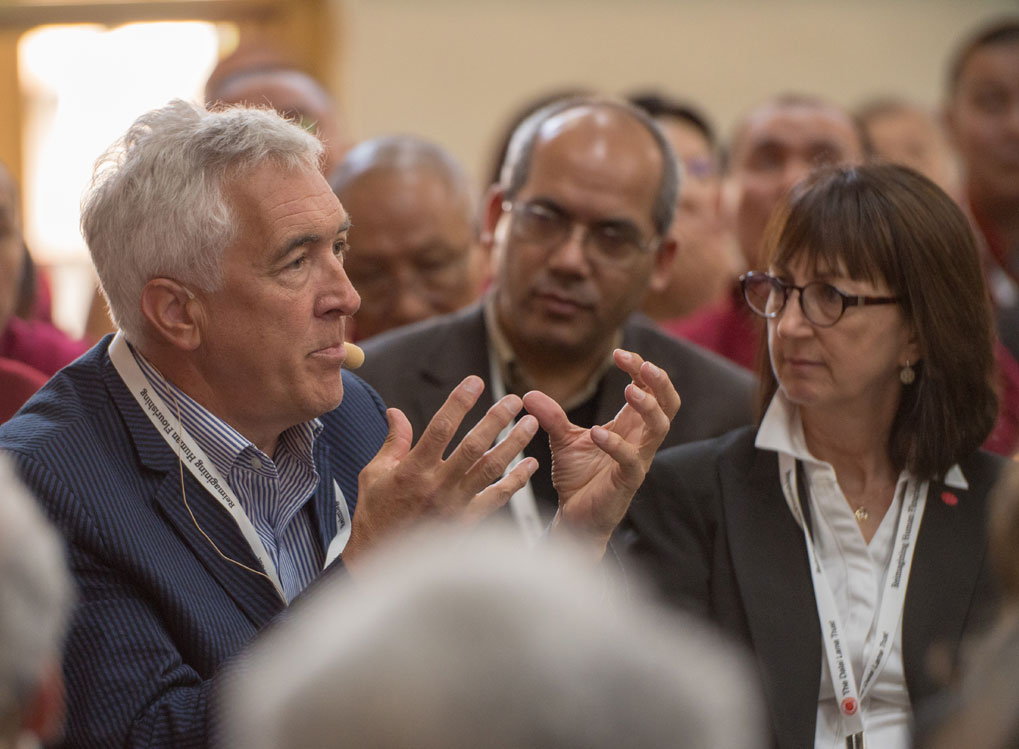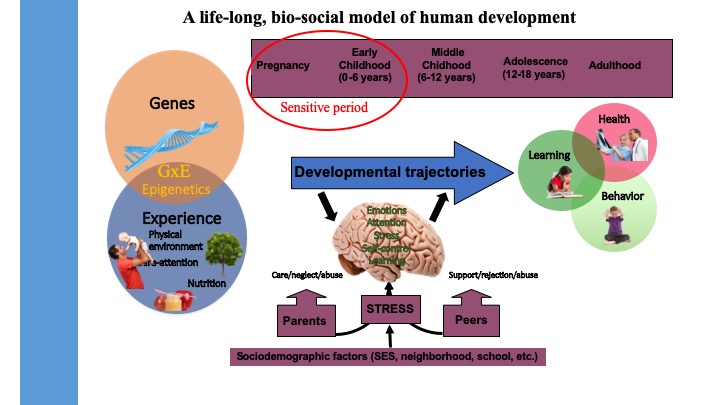What is the role of genetic and environmental factors in influencing child development? Is temperament determined from birth? To what extent can environmental enrichment factors—like social and emotional learning (SEL) interventions—shape development, behavior, and health?
Presenting the latest scientific findings on these difficult and perennial questions was developmental psychologist Michel Boivin. Boivin, Professor of Psychology and Director of the Research Unit on Children’s Psychosocial Maladjustment at Laval University in Canada, conducts longitudinal studies. That is, he follows a group of people over a long period of time to observe their paths of development. For example, in one current study Boivin is following 1,200 Montreal twins. Boivin wants to find out what accounts for the differences between children. Why are some children more anxious or aggressive than others? Why are some more successful in school than others?
"Why are some children more anxious or aggressive than others? Why are certain ones more successful in school than others?"
Boivin shared some of his findings. “The first lesson of these longitudinal studies,” he said, “is that developmental propensities are established very early in life.” (His current studies start tracking babies at five months of age.) “As soon as we can assess shyness or aggression with reliability, there’s a tendency for individual differences to appear. However, the extent to which they remain stable or change is very much a function of the extent to which the environment or context remains stable. Moreover, Richard Davidson, a presenter at the conference, and his colleagues demonstrated many years ago that extreme temperaments are indeed not stable over time. While some extremely shy or aggressive toddlers develop into anxious and antisocial adolescents, this is very much the exception rather than the rule.
But what accounts for these early differences?

There is no one explanation, said Boivin. “These trajectories are governed by a complex gene-environment interplay.” Many influences are at work: genetics; factors related to the child (such as gender: boys tend to be more aggressive than girls), to the family (such as economic stability), and to the parents (such as parental depression); and other factors Boivin calls “the usual suspects” (such as socioeconomic disadvantage and stress). “It is a cumulative effect of these,” he said, meaning the cumulative effect of gene by environment (experiential) factors that shape developmental lifepaths, not single genes or single experiences even.
And because so many factors contribute to shaping a child’s development, he cautioned, “there is a lot of variability in the ways children will respond to the environment.” That is, children seem to vary genetically in their susceptibility to various environmental experiences. This has profound implications for what scientists call “gene by treatment interactions.” “When you want to intervene,” Boivin continued, “it is important to consider that children exposed to the same intervention won’t respond to it the same way.” Some children might even experience a negative effect, he suggested. Of course, children also vary in their social experiences. Based on the psychology and biology of the child, this can also shape differential responsiveness to interventions like SEL. For instance, children who have experienced developmental adversity may require trauma-informed SEL approaches.
"When you want to intervene, it is important to consider that children exposed to the same intervention won’t respond in the same way." Michel Boivin
How Do Genes and Environments Shape Human Development?
Participants engaged in hearty discussion around the relative contributions of genetics and social experience to developmental lifepaths. “What do we know about the role of genetics, and to what extent are outcomes like disposition, behavior, and health the result of our genes?” were questions that were raised.
A significant misunderstanding that Boivin tried to address repeatedly is that genes are fixed entities that are independent of the environment, which itself is composed of independent factors impinging on the individual from without. However, this kind of dualistic thinking of biology (genes) vs. culture (social experience) in the shaping of individual lives has given way to a dialectical developmental view in which genes and environments are seen in transactional relation to one another—genes shaping responses to environments which feeds back onto gene expression, and environments shaping gene expression which feeds back onto the social systems. To examine this transactional dance, and more controversially, to try to parse apart so-called genetic and environmental inputs to development, Boivin is comparing pairs of identical twins (which are genetically the same) to pairs of fraternal twins (which are genetically different) to try to estimate the relative influences of genes and environment on specific domains of behavior.
“The lesson of twin studies around the world—including our own study—is that genes are important in accounting for individual differences with respect to social emotional dimensions or behavior problems, like aggression, shyness, or anxiety. They account for about 40 to 50 percent of individual differences,” Boivin reported. (Conversely, 50 to 60 percent are produced by environmental factors.) But the percentage that is genetic is also dependent on the environment, Boivin stressed, because the environment affects how those genes are expressed. “The key point,” he summarized, “is that genes are important. They account for a significant portion of individual differences, but they are not fixed entities; gene expression varies depending on the environment.”
"Genes are important. They account for a significant portion of individual differences, but genes are not fixed entities; gene expression varies depending on the environment." Michel Boivin
Conversely, the impact of environments on individuals also varies based on genetic factors. Thus, interventions like SEL can certainly impact children’s development, but when delivered as universal programs to all children, we might expect differential outcomes and impacts. Perhaps most important though is the recognition that interventions such as SEL can impact social and emotional development irrespective of the etiology of individual differences. In other words, it does not matter if a quality such as shyness is partially heritable. This fact says nothing about the extent to which it is modifiable by training.
Does the Timing of SEL Intervention Matter?
Given that enriched environments can significantly shape both biological and psychosocial development, the question arises of whether there may be “windows of opportunity” in the human lifespan when enrichment might interact with the malleability of the brain to produce significant impacts on child development. The brain is constantly changing, scientists say (they call this malleability ‘neuroplasticity’), but it changes in certain ways more during certain times in development than others. Science has now revealed that there are periods in the development of the human nervous system when a child’s susceptibility to learning in general, and to learning particular abilities, is heightened. This plasticity is lifelong and may even increase in some domains of functioning (e.g., wisdom), but in general, there is more malleability in the brain earlier in the lifespan.
The sensitive periods for social emotional skills—which are important windows of opportunity for SEL interventions—occur in early childhood, about the time of birth, between ages 4-7, and around age 12-13, said Richard Davidson. The perspectives of other presenters showed a lack of clear consensus on the age(s) at which interventions are most effective; yet there was agreement on the need to tailor SEL approaches so that they are developmentally appropriate and to focus on the periods outlined by Professor Davidson—early childhood and the transition to primary school, early adolescence around puberty and the transition to secondary school, and in early adulthood and the transition to work, post-secondary study, and so forth. Each of these transitional time periods in the first three decades of life represent windows of opportunity for the cultivation of social emotional skills and flourishing.

Slide image © Richard Davidson.
As discussed above, children with different experience need to be considered in the creation of developmentally appropriate programs that address diverse populations of young people. Exposure to trauma can negatively affect neuroplasticity, for instance, Davidson noted. “One of the fascinating things that we’ve learned in science is that when we are exposed to adversity, it actually diminishes the plasticity of the brain. It down-regulates genes that are responsible for plasticity itself, and so the very mechanisms of learning are impaired.” Here we see risky developmental environments can affect gene expression by “turning down” genes responsible for learning and development under “average-expectable conditions.” This illustrates the complexity of genes and environments that Boivin was discussing.
"One of the fascinating things that we've learned in science is that when we are exposed to adversity, it actually diminishes the plasticity of the brain. It down-regulates genes that are responsible for plasticity itself, and so the very mechanisms of learning are impaired." Richard Davidson
Boivin emphasized that interventions should begin in early childhood, even pre-birth. His view is based on current findings in the field of epigenetics. (See footnote.) The reason for pre-natal intervention, Boivin explained, is that many of the genes contributing to social emotional development are expressed during pregnancy, “so they tend to have a very large impact on the organization of the brain,” and consequently they can have a large impact across many characteristics. Thupten Jinpa, the Dalai Lama’s long-time English translator, who also presented at the conference, asked Boivin, “Is there a point beyond which there is not much you can do—say for example 20 or 25 years (of age)?”
“The brain science would say that you still have new changes in the brain in very old people, right,” Boivin replied. “So it is not over until it is over. The main point is that the window of opportunity is early childhood. There is a lot we can do to change things before they get consolidated by different developmental processes.”
“But isn’t it also true,” asked noted psychologist Daniel Goleman, “that the emotional and social circuitry of the brain continues to develop and mature into the mid-20s, which makes another window of opportunity during the school years?” That is correct, both Davidson and Boivin agreed. So it seems that change is easier, particularly at various points, in younger years, but it is still possible (though perhaps more difficult) as we age. But might not the kinds of social-emotional programs we offer be designed to respond to the development and growing capacities of the child? What would programs for those of different ages look like?
Educating the Heart Across the Lifespan
The Dalai Lama picked up on this line of discussion and wondered about whether focusing emotional education efforts on young children was the only, or even most effective way, to solve the crisis of emotion (see Chapter 3). Might there not be different methods for educating the heart in terms of what the Dalai Lama has called an ethic of restraint, an ethic of virtue, and an ethic of altruism? And what role might reason play in such efforts?
The Dalai Lama gave examples of when individuals use critical reasoning to begin a process of change. Adults would have a better ability to do that, he argued, because the ability to analyze depends on a more mature human brain. Might programs for those in their later adolescent and early adulthood years harness the increased cognitive maturity of this age group to reflect and analyze emotions in ways that lead to flourishing? Indeed, beyond the childhood years there is a rich line of applied research on educating the heart during the adolescent (ages 10-18) and early adulthood years (ages 18-25) that shows significant promise. The Dalai Lama’s comment highlights a key point in this work, namely that different age groups require different types of intervention that call upon developmentally appropriate abilities.
“In order to bring about more change,” he explained, “you need to actually internalize that knowledge and process it through sustained thinking and application.” Still deeper certitude and change result when that internalized understanding gets embodied as the result of meditative cultivation. That is, there is analysis and understanding of emotion based on reason, then there is the progressive effort to embody this understanding of emotion in one’s own life through a variety of practices. In this way, cognitive view becomes embodied behavior.
Enlarge

This cognitive approach to emotion is critical, the Dalai Lama proposed, because our emotions distort reality. He then gave an example. Anger exaggerates the negative qualities of the person or thing you are angry at. “Today you feel angry with someone; next week that person can become a good friend,” he said. At the moment of anger, the person appears very negative, he added, almost like an absolute enemy. “If that is the reality, then it is impossible to change next week,” he reasoned. “All these are mental projections; it is very clear.”
“These things we call ‘wisdom’—actually fully knowing the reality,” the Dalai Lama said, “that, I think, is a real basis of our hope.” Because appearances are deceptive, knowing reality requires critical analysis. The purpose of an education of the heart, in the Dalai Lama’s view, should be to teach this critical faculty. “Education provides more ability to analyze things, so then automatically the negative emotions can reduce.”
Thus, the Dalai Lama was raising profound questions about how to educate the heart, about the role of reasoning in this educating of the heart, and of considering not only early development but also adolescence and early adulthood as key periods for an education for flourishing. These remarks presage later sessions on how best to educate the heart of children, youth, and young adults.
In Chapter 5 “Educating for a Shared Humanity: Two SEL Approaches” leading SEL researchers and practitioners, inspired by the Dalai Lama, share new approaches and curricula for educating the heart. To learn about the role of genetics, evolutionary tendencies, and social experiences in the shaping of ethical development, see Chapter 8 “Integrating Wisdom and Science in Educating the Heart”.
What is Epigenetics?
Epigenetics is the study of how people (and other organisms) can inherit characteristics that are caused by something other than their genetic DNA sequence. Such epigenetic changes often involve systems that control gene expression (the way that genes are turned into proteins and become functionally active in the body). Many studies have found that epigenetic changes occur in the prenatal environment, and maternal conditions like stress, toxin exposure, and viral infection can have lasting impact on the developing fetus. For example, maternal stress has been linked to epigenetic regulation of genes in the baby that are critical for neuroplasticity—with possible long-term effects for the child’s learning and behavior.
